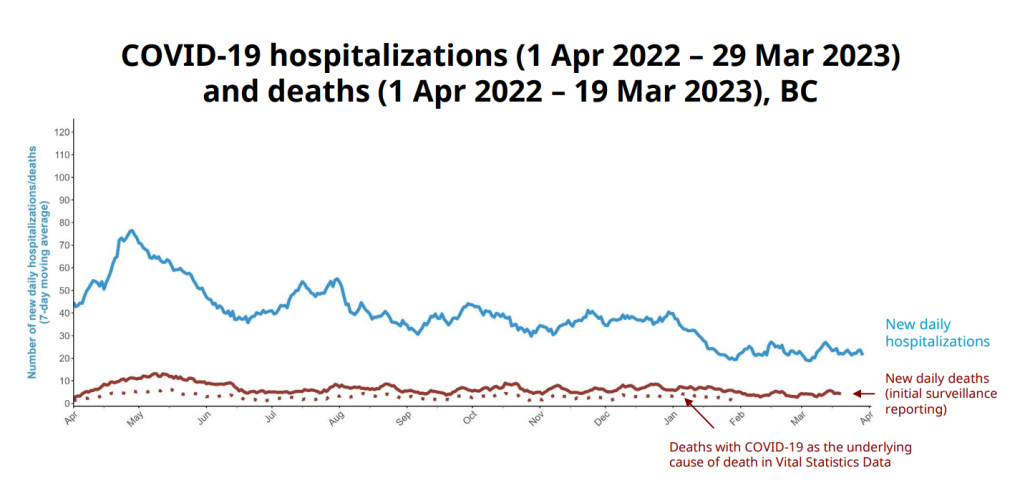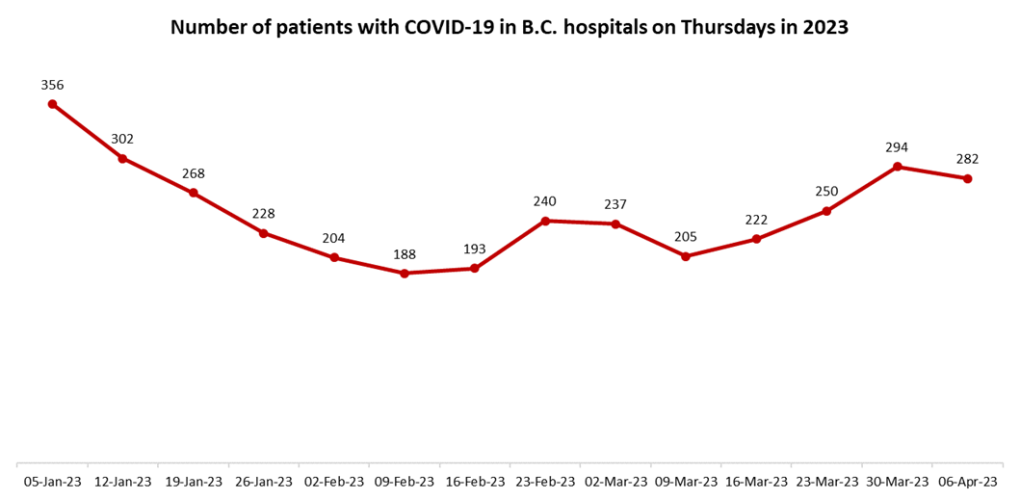Number in hospital with COVID-19 in B.C. declines for first time in weeks
Following three weeks of increases, the number of people hospitalized with COVID-19 in B.C. fell slightly to 282 on Thursday, according to the latest data from the B.C. Centre for Disease Control.
Thursday's numbers were released as provincial health officer Dr. Bonnie Henry and Health Minister Adrian Dix spoke at a news conference, during which they announced the ends of most of the province's remaining pandemic-related mandates.
The health officials announced that masks are no longer universally required in health-care settings, and visitors to long-term care homes no longer have to show proof of vaccination, nor take a rapid test, before their visits.
During her remarks, Henry presented data on new hospital admissions – a different metric than the number currently in hospital, which is sometimes called the "hospital census" – and characterized them as part of a long, downward trend.
"As you know, for the last year, the COVID-19 that we've been seeing has all been variants of Omicron," Henry said. "What we have seen is a levelling-off and a decreasing of hospitalizations."
Over the last three weeks, there has been an upward trend in new hospital admissions. Last week, the BCCDC reported 135 new hospital admissions for the week of March 19 to 25, a figure that has been revised upwards to 165 in this week's data.
On Thursday, the BCCDC reported 146 new hospital admissions from March 26 to April 1, a higher starting point than the initial 135 from last week.
Looking at the long-term trend in the data, however, Henry's point about hospitalizations levelling off and decreasing is accurate.
 New hospital admissions over time are shown in this slide from Henry's presentation. (BCCDC)
New hospital admissions over time are shown in this slide from Henry's presentation. (BCCDC)
Indeed, the hospital census, which looks at the number of people currently in hospital, shows the same trend.
Before this week, the total had been increasing fairly rapidly since early March.
 The number of people in B.C. hospitals with COVID-19 on Thursdays in 2023 is shown. (CTV)
The number of people in B.C. hospitals with COVID-19 on Thursdays in 2023 is shown. (CTV)
Looking back as far as 2022, however, the number of people in hospital with COVID-19 remains low relative to where it once was.
 The number of people with COVID-19 in B.C. hospitals on Thursdays since the province switched to a "hospital census" model in January 2022 is shown. (CTV)
The number of people with COVID-19 in B.C. hospitals on Thursdays since the province switched to a "hospital census" model in January 2022 is shown. (CTV)
Notably, all of the hospitalization figures reported in the weekly update include a substantial number of people who are in hospital for reasons unrelated to their COVID diagnosis, a fact Henry reiterated multiple times on Thursday.
In the past, health officials have estimated that between 40 and 50 per cent of people in hospital with COVID-19 at a given time are there because of the disease, while the rest are admitted for other reasons and test positive incidentally.
CHANGES COMING TO DATA REPORTING
Henry also announced that Thursday's update would be the last one to be provided weekly for the foreseeable future.
The provincial health officer said the BCCDC is changing its COVID-19 data reporting procedures and will be providing data on the coronavirus and other respiratory illnesses less frequently going forward.
"As we usually do once flu season is settling down and the typical respiratory season is settling down, we go to a longer interval," Henry said.
Updates will be provided biweekly until May 4, at which point the province will issue its end-of-season report for respiratory illnesses other than COVID.
"For COVID, we are going to continue, because we're still in that transition period with the pandemic, and there's still some uncertainty about where we're going to be," Henry said.
After May 4, the BCCDC will be publishing COVID-19 data on a monthly basis.
REVISED WASTEWATER SURVEILLANCE
For the last several weeks, as hospitalizations and the official case count in B.C. rose, concentrations of SARS-CoV-2 in wastewater around the province appeared to be skyrocketing.
Two weeks ago, the BCCDC acknowledged that it had begun using a more sensitive test on Feb. 28, and explained that this change was likely contributing to the apparent surge.
On Thursday, Henry said that the agency had completed its retesting of archived samples and released revised data for the past year. The result? Data on the BCCDC website now shows decreasing trends in virus concentrations throughout the month of March.
As of Thursday's update, only the Penticton treatment plant showed an increase for the most recent week.
CTVNews.ca Top Stories

opinion Tom Mulcair: Prime Minister Justin Trudeau's train wreck of a final act
In his latest column for CTVNews.ca, former NDP leader and political analyst Tom Mulcair puts a spotlight on the 'spectacular failure' of Prime Minister Justin Trudeau's final act on the political stage.
B.C. mayor gets calls from across Canada about 'crazy' plan to recruit doctors
A British Columbia community's "out-of-the-box" plan to ease its family doctor shortage by hiring physicians as city employees is sparking interest from across Canada, says Colwood Mayor Doug Kobayashi.
'There’s no support': Domestic abuse survivor shares difficulties leaving her relationship
An Edmonton woman who tried to flee an abusive relationship ended up back where she started in part due to a lack of shelter space.
opinion King Charles' Christmas: Who's in and who's out this year?
Christmas 2024 is set to be a Christmas like no other for the Royal Family, says royal commentator Afua Hagan. King Charles III has initiated the most important and significant transformation of royal Christmas celebrations in decades.
Can the Governor General do what Pierre Poilievre is asking? This expert says no
A historically difficult week for Prime Minister Justin Trudeau and his Liberal government ended with a renewed push from Conservative Leader Pierre Poilievre to topple this government – this time in the form a letter to the Governor General.
Baseball Hall of Famer Rickey Henderson dead at 65, reports say
Rickey Henderson, a Baseball Hall of Famer and Major League Baseball’s all-time stolen bases leader, is dead at 65, according to multiple reports.
Arizona third-grader saves choking friend
An Arizona third-grader is being recognized by his local fire department after saving a friend from choking.
Germans mourn the 5 killed and 200 injured in the apparent attack on a Christmas market
Germans on Saturday mourned the victims of an apparent attack in which authorities say a doctor drove into a busy outdoor Christmas market, killing five people, injuring 200 others and shaking the public’s sense of security at what would otherwise be a time of joy.
Blake Lively accuses 'It Ends With Us' director Justin Baldoni of harassment and smear campaign
Blake Lively has accused her 'It Ends With Us' director and co-star Justin Baldoni of sexual harassment on the set of the movie and a subsequent effort to “destroy' her reputation in a legal complaint.

































